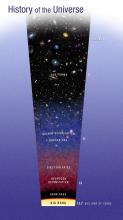Listen to today's episode of StarDate on the web the same day it airs in high-quality streaming audio without any extra ads or announcements. Choose a $8 one-month pass, or listen every day for a year for just $30.
You are here
Making Gold
Gold and silver are beautiful, but they’re also rare — they account for only a few parts per billion of Earth’s crust.
These and other heavy elements, such as uranium and platinum, are so rare because they’re hard to make. They contain many protons and neutrons, and it’s hard to create the conditions needed to make all those particles stick together.
Some of these elements may be formed in the titanic explosions known as supernovae. But it takes the right kind of explosion to make these heavy elements. Such blasts don’t appear to be common enough to supply all of these elements that are seen in the universe.
So scientists have looked for other possible birthplaces. One possibility is the merger of two neutron stars — the dense, heavy cores of exploded stars. The merger spins off matter, which could stick together to form gold and other heavy elements.
A recent study proposed an even more exotic possibility: a small black hole eating a neutron star. The idea says that small black holes were created shortly after the Big Bang. Occasionally, one of them rams into a neutron star and settles in the star’s core.
As the black hole devours the surrounding material, the neutron star spins faster. Eventually, it may spin fast enough to sling material from its surface out into space. Some of the material could then stick together to form the nuclei of gold, silver, and other heavy elements: cosmic creation from a cosmic death.
Script by Damond Benningfield



